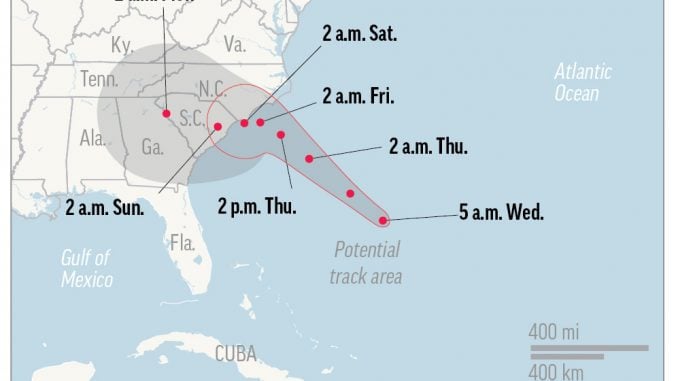
WILMINGTON — Communities along the Carolina coast buttoned up against the onslaught of Hurricane Florence as forecasters Wednesday warned that the monstrous storm could hesitate just offshore for days — punishing a longer stretch of coastline than previously feared — before pushing its way inland.
The National Hurricane Center’s projected track had Florence hovering off the southern North Carolina coast from Thursday night until landfall Saturday morning or so, about a day later than previously expected. The track also shifted somewhat south and west, throwing Georgia into peril as Florence moves inland.
The overall trend is “exceptionally bad news,” said University of Miami hurricane researcher Brian McNoldy, since it “smears a landfall out over hundreds of miles of coastline, most notably the storm surge.”
As of 8 a.m. Wednesday, Florence, a potentially catastrophic Category 4 storm, was centered 530 miles (855 kilometers) southeast of Cape Fear, North Carolina, moving at 17 mph. It was packing winds of 130 mph and enough moisture to dump feet of rain on the region.
With South Carolina’s beach towns more in the bull’s-eye, Ohio vacationers Chris and Nicole Roland were trying to time their evacuation from North Myrtle Beach to get the maximum amount of time on the sand. Most other beachgoers were long done.
“It’s been really nice,” Nicole Roland said. “Also, a little creepy. You feel like you should have already left.”
“This is not going to be a glancing blow,” Jeff Byard, an administrator with the Federal Emergency Management Agency, warned. “This is going to be a Mike Tyson punch to the Carolina coast.”
While some said they planned to stay put despite hurricane watches and warnings extending over the homes of more than 5.4 million people on the East Coast, many weren’t taking any chances.
Steady streams of vehicles full of people and belongings flowed inland Tuesday as North Carolina Gov. Roy Cooper tried to convince everyone on North Carolina’s coast to flee.
“The waves and the wind this storm may bring is nothing like you’ve ever seen. Even if you’ve ridden out storms before, this one is different. Don’t bet your life on riding out a monster,” he said.
President Donald Trump declared states of emergency for North and South Carolina and Virginia, opening the way for federal aid. He said the federal government is “absolutely, totally prepared” for Florence.
All three states ordered mass evacuations along the coast. But getting out of harm’s way has proved difficult since airlines were canceling flights and motorists had a hard time finding fuel.

Michelle Stober loaded up valuables on Tuesday at her home on Wrightsville Beach to drive back to her primary residence in Cary, North Carolina.
“This morning I drove around for an hour looking for gas in Cary. Everyone was sold out,” she said.
Florence is the most dangerous of three tropical systems in the Atlantic. Tropical Storm Isaac was expected to pass south of Puerto Rico, Haiti, the Dominican Republic and Cuba, while Hurricane Helene was moving northward away from land. Forecasters also were tracking two other disturbances.
